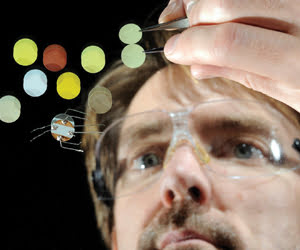DoE lab combines materials design, systems analysis and more in developing solar technologies
Researchers anticipate that the world’s energy needs will double by 2050. To help meet
these ballooning needs, the US Department of Energy (DoE)’s Argonne National
Laboratory in Illinois recently launched an Alternative Energy & Efficiency
Initiative. The initiative seeks, in part, to achieve advances toward the large-scale
implementation of solar energy by drawing on the laboratory’s strengths in
basic and applied research and in collaborating with industry and other research
organizations.
“Solar energy has more potential than any other renewable
source,” said Seth B. Darling, a researcher with the laboratory. But realizing
that potential is always going to be challenging – particularly with respect
to cost. “Government subsidies can artificially lower the cost of a technology,
but you need the unsubsidized cost to be competitive.”

The US Department of Energy’s Argonne National Laboratory in
Illinois has launched an Alternative Energy & Efficiency Initiative, through
which it seeks to develop new technologies, working toward large-scale implementation
of solar energy, for example. Photos courtesy of Argonne National Laboratory.
And then, it must be competitive in the long term. Consider cadmium
telluride. Using this, we could reach grid parity – the point at which renewable
energy costs as little as or less than grid power – in a relatively few years.
But tellurium, which comprises half of cadmium telluride, is one of the rarest materials
on Earth. “It will be great as a stopgap,” said Darling, “but,
ultimately, it cannot supply the world’s needs.” Therefore, we need
new materials and new technologies.
This much is generally understood. The trick, of course, is to
identify the technologies that will successfully address the energy security issue.
“What we believe here,” Darling said, “is that having a basic
researcher sitting in his or her lab developing a new technology, hoping to serendipitously
hit upon something that will solve the problem, is not the most efficient approach.
Likewise, endlessly tweaking an existing technology may not be the answer.”
Argonne is working toward an integrated approach combining its
materials design, device science and process engineering. This will help to determine
early in the process, for example, whether a technique can be scaled up to the necessary
extent. Systems analysis is another strength that Argonne will add to the mix, studying
the impact and interplay of resource limitations, the variability of sunshine, consumer
behavior and more, with respect to a potential technology.

Argonne National Laboratory is exploring the potential of atomic
layer deposition, among other techniques. Here, researcher Jeffrey W. Elam examines
solar cell materials prepared using the method at various stages of fabrication.
This approach is not necessarily unique, but applying it to technologies
that look promising can help us to achieve energy security more quickly than we
would otherwise, Darling said. And that, of course, is the ultimate goal.
One technology the researchers are exploring is atomic layer deposition
(ALD), which allows them to prepare extremely thin layers of transparent conductors,
essential components of most solar cells. With conventional dye-sensitized solar
cells, performance is limited by sluggish charge transport through the photoanode.
“ALD offers the potential to improve DSSC [dye-sensitized solar cell] efficiency
by enabling the fabrication of high-surface-area photoanodes with high conductivity,”
said Jeffrey W. Elam, director of the atomic layer deposition program at Argonne.
The technique has further advantages: It produces highly conformal
coverage, even on three-dimensional structures, and allows synthesis of a broad
range of materials relevant to dye-sensitized solar cells, including titanium dioxide,
indium oxide and tin oxide.
Elam noted a significant challenge in working with the technique:
Every new material one might want to prepare requires research to develop the appropriate
atomic layer deposition “recipe,” providing the necessary self-limiting
surface chemistry.
Early in its DSSC development work, the Argonne group encountered
the lack of an appropriate atomic layer deposition chemistry for indium oxide, the
main ingredient in indium tin oxide (ITO), one of the best transparent conductors
known. To address this, he said, “we invented a method for preparing highly
conformal ALD ITO coatings on nano-porous structures and used this method to fabricate
DSSCs with excellent charge-transport properties.”
The researchers believe that applying the technique to the deposition
of ITO will help usher in the next generation of photovoltaics, enhancing the performance
and reducing the cost. Also, extending it to alternative, Earth-abundant transparent
conductors ultimately could enable production of efficient solar energy devices
on a massive scale.